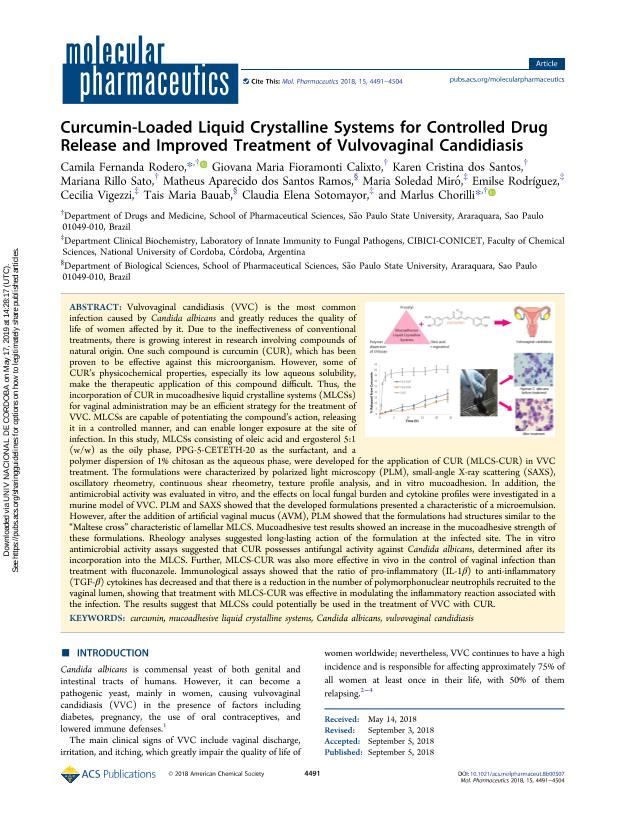Artículo
Curcumin-Loaded Liquid Crystalline Systems for Controlled Drug Release and Improved Treatment of Vulvovaginal Candidiasis
Rodero, Camila Fernanda; Fioramonti Calixto, Giovana Maria; dos Santos, Karen Cristina; Sato, Mariana Rillo; Aparecido dos Santos Ramos, Matheus; Miró, María Soledad ; Rodriguez, Emilse
; Rodriguez, Emilse ; Vigezzi, Cecilia
; Vigezzi, Cecilia ; Bauab, Tais Maria; Sotomayor, Claudia Elena
; Bauab, Tais Maria; Sotomayor, Claudia Elena ; Chorilli, Marlus
; Chorilli, Marlus
 ; Rodriguez, Emilse
; Rodriguez, Emilse ; Vigezzi, Cecilia
; Vigezzi, Cecilia ; Bauab, Tais Maria; Sotomayor, Claudia Elena
; Bauab, Tais Maria; Sotomayor, Claudia Elena ; Chorilli, Marlus
; Chorilli, Marlus
Fecha de publicación:
10/2018
Editorial:
American Chemical Society
Revista:
Molecular Pharmaceutics
ISSN:
1543-8384
Idioma:
Inglés
Tipo de recurso:
Artículo publicado
Clasificación temática:
Resumen
Vulvovaginal candidiasis (VVC) is the most common infection caused by Candida albicans and greatly reduces the quality of life of women affected by it. Due to the ineffectiveness of conventional treatments, there is growing interest in research involving compounds of natural origin. One such compound is curcumin (CUR), which has been proven to be effective against this microorganism. However, some of CUR's physicochemical properties, especially its low aqueous solubility, make the therapeutic application of this compound difficult. Thus, the incorporation of CUR in mucoadhesive liquid crystalline systems (MLCSs) for vaginal administration may be an efficient strategy for the treatment of VVC. MLCSs are capable of potentiating the compound's action, releasing it in a controlled manner, and can enable longer exposure at the site of infection. In this study, MLCSs consisting of oleic acid and ergosterol 5:1 (w/w) as the oily phase, PPG-5-CETETH-20 as the surfactant, and a polymer dispersion of 1% chitosan as the aqueous phase, were developed for the application of CUR (MLCS-CUR) in VVC treatment. The formulations were characterized by polarized light microscopy (PLM), small-angle X-ray scattering (SAXS), oscillatory rheometry, continuous shear rheometry, texture profile analysis, and in vitro mucoadhesion. In addition, the antimicrobial activity was evaluated in vitro, and the effects on local fungal burden and cytokine profiles were investigated in a murine model of VVC. PLM and SAXS showed that the developed formulations presented a characteristic of a microemulsion. However, after the addition of artificial vaginal mucus (AVM), PLM showed that the formulations had structures similar to the "Maltese cross" characteristic of lamellar MLCS. Mucoadhesive test results showed an increase in the mucoadhesive strength of these formulations. Rheology analyses suggested long-lasting action of the formulation at the infected site. The in vitro antimicrobial activity assays suggested that CUR possesses antifungal activity against Candida albicans, determined after its incorporation into the MLCS. Further, MLCS-CUR was also more effective in vivo in the control of vaginal infection than treatment with fluconazole. Immunological assays showed that the ratio of pro-inflammatory (IL-1β) to anti-inflammatory (TGF-β) cytokines has decreased and that there is a reduction in the number of polymorphonuclear neutrophils recruited to the vaginal lumen, showing that treatment with MLCS-CUR was effective in modulating the inflammatory reaction associated with the infection. The results suggest that MLCSs could potentially be used in the treatment of VVC with CUR.
Archivos asociados
Licencia
Identificadores
Colecciones
Articulos(CIBICI)
Articulos de CENTRO DE INV.EN BIOQUI.CLINICA E INMUNOLOGIA
Articulos de CENTRO DE INV.EN BIOQUI.CLINICA E INMUNOLOGIA
Citación
Rodero, Camila Fernanda; Fioramonti Calixto, Giovana Maria; dos Santos, Karen Cristina; Sato, Mariana Rillo; Aparecido dos Santos Ramos, Matheus; et al.; Curcumin-Loaded Liquid Crystalline Systems for Controlled Drug Release and Improved Treatment of Vulvovaginal Candidiasis; American Chemical Society; Molecular Pharmaceutics; 15; 10; 10-2018; 4491-4504
Compartir
Altmétricas



